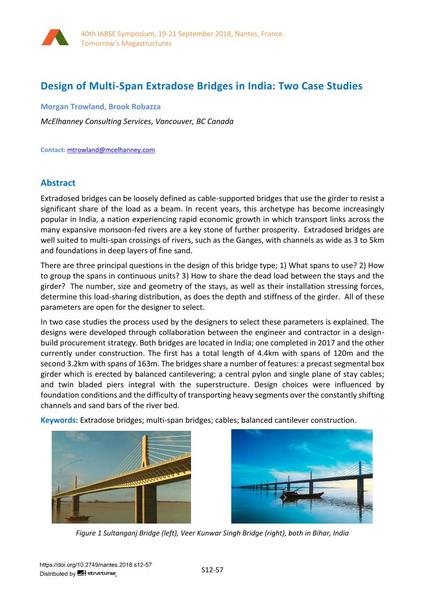Design of Multi-Span Extradose Bridges in India: Two Case Studies

|
|
|||||||||||
Bibliographic Details
| Author(s): |
Morgan Trowland
(McElhanney Consulting Services, Vancouver, BC Canada)
Brook Robazza (McElhanney Consulting Services, Vancouver, BC Canada) |
||||
|---|---|---|---|---|---|
| Medium: | conference paper | ||||
| Language(s): | English | ||||
| Conference: | IABSE Symposium: Tomorrow’s Megastructures, Nantes, France, 19-21 September 2018 | ||||
| Published in: | IABSE Symposium Nantes 2018 | ||||
|
|||||
| Page(s): | S12-57 | ||||
| Total no. of pages: | 8 | ||||
| DOI: | 10.2749/nantes.2018.s12-57 | ||||
| Abstract: |
Extradosed bridges can be loosely defined as cable-supported bridges that use the girder to resist a significant share of the load as a beam. In recent years, this archetype has become increasingly popular in India, a nation experiencing rapid economic growth in which transport links across the many expansive monsoon-fed rivers are a key stone of further prosperity. Extradosed bridges are well suited to multi-span crossings of rivers, such as the Ganges, with channels as wide as 3 to 5km and foundations in deep layers of fine sand. There are three principal questions in the design of this bridge type; 1) What spans to use? 2) How to group the spans in continuous units? 3) How to share the dead load between the stays and the girder? The number, size and geometry of the stays, as well as their installation stressing forces, determine this load-sharing distribution, as does the depth and stiffness of the girder. All of these parameters are open for the designer to select. In two case studies the process used by the designers to select these parameters is explained. The designs were developed through collaboration between the engineer and contractor in a design- build procurement strategy. Both bridges are located in India; one completed in 2017 and the other currently under construction. The first has a total length of 4.4km with spans of 120m and the second 3.2km with spans of 163m. The bridges share a number of features: a precast segmental box girder which is erected by balanced cantilevering; a central pylon and single plane of stay cables; and twin bladed piers integral with the superstructure. Design choices were influenced by foundation conditions and the difficulty of transporting heavy segments over the constantly shifting channels and sand bars of the river bed. |
||||
| Keywords: |
extradosed bridge ropes cables Balanced cantilever construction multi-span bridges
|
||||

